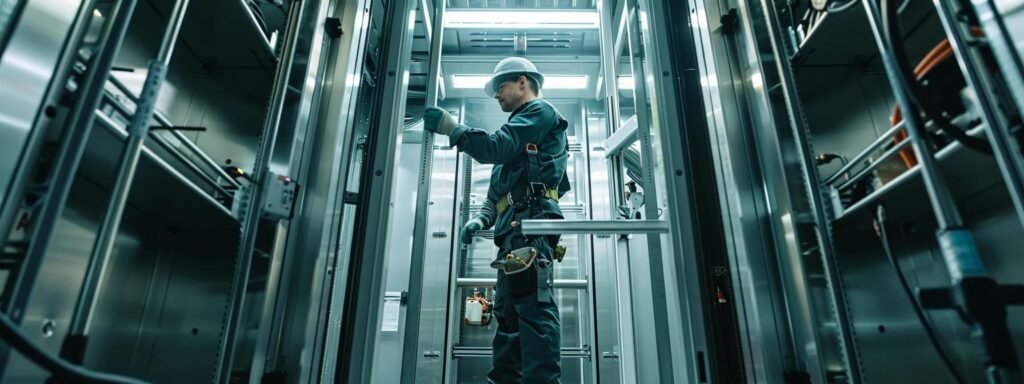
Elevate Your Building's Lifts with Professional Services
In the realm of building management and vertical transportation, lift services are essential for safely and efficiently moving people and goods. Building owners and facility managers need reliable lift maintenance, rapid emergencyrepair solutions, and professional installation services to meet safety standards and regulatory compliance. This guide serves as a comprehensive resource that defines key industry terms and offers actionable insights on optimizing lift performance and longevity. It highlights the benefits of regular maintenance, the need for prompt repairs, and the importance of professional installations—all crucial for ensuring sustained operational efficiency and protecting your investment.
What Is Lift Maintenance and Why Is It Essential?
Lift maintenance is a systematic approach to the care and repair of lift systems that keeps them operating safely and reliably. Regular inspections, lubrication, adjustments, and parts replacement prevent unexpected shutdowns and reduce repair times. This proactive care enhances user safety, extends the lift’s life, and supports efficient performance by addressing minor issues before they escalate.
What Are the Different Types of Elevator Maintenance?
Elevator maintenance can be preventive, corrective, or predictive. Preventive maintenance involves scheduled inspections and minor repairs to avoid breakdowns. Corrective maintenance addresses issues after faults occur, while predictive maintenance uses diagnostic tools, including IoT sensors, to anticipate problems before they lead to failure. This layered approach improves uptime, energy efficiency, and overall system reliability.
How Does Regular Lift Maintenance Improve Safety and Reliability?
Regular maintenance minimizes risks by detecting wear and tear early. Routine check-ups allow instant corrective action, reduce downtime, and prevent severe malfunctions. Continuous monitoring of hydraulic systems, electrical circuits, and mechanical components contributes to safer operations and offers peace of mind for both users and building managers.
What Does a Typical Lift Maintenance Checklist Include?
A complete lift maintenance checklist covers mechanical inspections of cables, pulleys, and counterweights, and electrical checks of control panels and wiring. It includes lubrication of moving parts, tests for emergency communication systems, verification of lighting and indicators, and checks of safety devices such as overspeed governors and door sensors. Proper documentation ensures compliance with safety standards and helps anticipate future maintenance needs.
How Do Lift Maintenance Contracts Work?
Lift maintenance contracts are agreements between building owners and service providers outlining scheduled inspections, repairs, and parts replacements over a set period. These contracts, often bundled with upgrades and emergency services at fixed fees, provide predictable costs and long-term relationships. Transparent pricing and comprehensive coverage, including spare parts and labor, ensure that lifts remain in expert care while meeting industry standards and safety regulations.
How Does Emergency Lift Repair Work and When Is It Needed?

Emergency lift repair is an urgent service that restores lift operations following unexpected breakdowns. Available 24/7, these services address safety-threatening malfunctions—such as motor issues, cable damage, and sensor errors—by conducting on-site assessments, applying temporary fixes, and scheduling complete repairs. The speed of response significantly reduces downtime and potential safety risks.
What Are the Most Common Lift Problems Requiring Emergency Repair?
Common emergency issues include door misalignments, sensor failures, motor malfunctions, and control panel errors. For example, faulty door sensors can cause lifts to stop mid-operation, while worn cables and brakes pose serious hazards. Regular maintenance helps identify issues early; however, unexpected failures still occur and require prompt intervention to ensure continued safe operation.
How Fast Is 24/7 Emergency Lift Repair Response?
Most emergencyrepair services guarantee a response within 60 minutes. Rapid response teams, often aided by remote diagnostic tools, can quickly assess problems and prepare necessary parts. This swift turnaround minimizes service disruption and maintains safety standards, ensuring customer satisfaction and uninterrupted lift functionality.
What Basic Troubleshooting Can Users Perform Before Help Arrives?
Before professional help arrives, users can reset the control panel, check for loose connections, and use emergency stop/reset functions if safe to do so. These basic steps provide useful information to technicians but should not replace professional intervention since advanced repairs require expert handling.
Why Choose Certified Technicians for Emergency Lift Repair?
Certified technicians possess the specialized training and industry-recognized credentials needed to handle complex lift systems. Their expertise ensures that repairs meet current safety and regulatory requirements. Utilizing advanced diagnostic tools, these professionals reduce repair times and lower the risk of future malfunctions, ensuring reliable and compliant service.
What Are the Key Steps in Lift Installation Services?
Lift installation is a detailed process requiring careful planning, custom design, and strict adherence to safety codes. From the initial consultation to final commissioning, professional installation ensures that a lift is integrated seamlessly into a building’s infrastructure, whether for new construction or an upgrade to an existing system.
What Types of Lifts Can Be Installed?
A variety of lifts can be installed based on building needs, including passenger lifts, freight lifts, service lifts, and dumbwaiters. Modern installations also include accessible lifts for individuals with disabilities, escalators, and even moving walkways. Each type is designed for specific functions—passenger lifts focus on comfort and speed, while freight lifts emphasize robust safety features and heavy-duty performance.
What Is the Typical Lift Installation Process?
The installation process begins with site surveys and obtaining regulatory clearance. During the design phase, precise specifications are drawn up, followed by mechanical and electrical installation of the hoist, control systems, and safety features. Commissioning involves comprehensive testing and user training to ensure that the lift operates safely and efficiently from day one.
How Does Lift Installation Improve Building Accessibility and Value?
Installing a modern lift enhances building accessibility by providing efficient vertical transportation. Improved lift systems increase property marketability and can lead to long-term savings through energy efficiency. Additionally, advanced safety features and modern aesthetics contribute to higher property values and tenant satisfaction.
What Should You Expect From Professional Lift Installation Providers?
Professional providers offer complete packages, from initial design to post-installation support. They adhere strictly to local building codes and industry standards, tailor solutions to specific site conditions, and often extend these services with maintenance contracts. Transparent pricing, thorough warranties, and responsive customer support are hallmarks of reputable installation providers.
How Much Do Lift Services Cost?

Lift service costs vary based on the lift type, usage frequency, maintenance complexity, and installation requirements. Cost estimates generally include labor, parts, and compliance with regulations. Building owners should consider both initial expenses and long-term costs when budgeting. Transparent and detailed pricing helps in making informed decisions that balance upfront investments with operational savings.
What Factors Affect Elevator Maintenance Costs?
Maintenance costs are influenced by the lift’s age, usage intensity, and system complexity. Regular preventive maintenance helps lower large repair costs. Factors such as geographic location and labor expenses also play a role. While advanced diagnostic tools may increase initial costs, they often reduce overall downtime and extend the equipment’s lifespan.
How Are Emergency Lift Repair Costs Determined?
Emergencyrepair costs depend on how quickly a response is needed, the complexity of the fault, and part availability. After-hours repairs typically incur premium charges. Reputable companies use transparent pricing, providing detailed cost breakdowns so that building owners understand exactly what they are paying for without unexpected expenses.
What Influences Lift Installation Pricing?
Installation pricing is driven by the type of lift, building architecture, required safety features, and design specifications. Costs differ for new construction versus retrofitting projects. Detailed quotations ensure that every component—from mechanical systems to control setups—is clearly itemized, allowing customers to compare options and identify the best value solutions.
How Does Transparent Pricing Benefit Customers?
Transparent pricing offers clarity on what is included in the service, facilitating accurate budgeting and informed decision-making. Clear pricing builds trust between service providers and building owners, enabling fair comparisons and smoother contract negotiations. This openness helps avoid unexpected charges and ensures the best balance of cost and quality.
Which Lift Service Providers Should You Choose?
Choosing the right provider is critical for maintaining safe and efficient lift operations. Providers vary in service breadth, response times, and regulatory adherence. Reviews, certifications, and proven track records are key indicators of reliability. Building owners should conduct detailed research and comparisons to select a partner that meets operational needs and budget goals.
What Qualifications and Certifications Should Lift Technicians Have?
Technicians should have industry-specific certifications (such as those from the National Association of Elevator Contractors) to ensure they are skilled in modern and traditional lift technologies. Continuous training and a history of working with various lift systems are also essential for meeting current safety norms and delivering quality service.
How Do Apex Lifts and Other Providers Ensure Reliable Service?
Leading providers like Apex Lifts offer comprehensive maintenance contracts and employ certified technicians. They use smart diagnostic technologies to monitor lift performance and update service protocols in line with industry innovations. Their commitment to training and rapid emergency response builds a reputation for reliable and efficient service.
What Are the Advantages of Local vs. Global Lift Service Companies?
Local companies provide prompt and personalized service with deep knowledge of regional codes, while global providers offer standardized quality and advanced technologies. Clients must weigh the benefits of immediate localized attention against broader service networks, choosing based on their specific operational needs and service expectations.
How Can Customer Testimonials and Reviews Guide Your Choice?
Customer reviews and testimonials offer real-world insights into a provider’s responsiveness, reliability, and service quality. They serve as valuable indicators of performance and help prospective clients gauge whether a provider’s standards align with their own expectations, ensuring informed decision-making.
What Are the Latest Trends in Lift Service and Technology?

Technological advances are rapidly shaping the lift industry. Trends include the use of IoT sensors for predictive maintenance, energy-efficient drive systems, and modernization upgrades that extend older elevators’ lifecycles. These innovations focus on sustainability, reduced energy consumption, and enhanced safety standards, often integrated into platforms that enable real-time monitoring and streamlined repair scheduling.
How Are Smart Lifts Changing Maintenance and Repair?
Smart lifts utilize IoT sensors and remote monitoring to continuously track performance parameters such as motor load, vibration, and temperature. This proactive approach enables predictive maintenance that reduces emergency repairs, minimizes downtime, and extends system life while optimizing maintenance schedules.
What Are the Benefits of Lift Modernization and Energy Efficiency Upgrades?
Modernization projects upgrade mechanical and control systems, resulting in improved performance, reliability, and energy efficiency. New drive motors and regenerative braking systems lower energy usage, while aesthetic and safety upgrades enhance both property value and user satisfaction. Such upgrades also reduce long-term maintenance costs by lessening component wear.
How Is Accessibility Being Improved Through Lift Services?
Modern lift systems emphasize accessibility for all users. Features such as voice-activated controls, tactile buttons, and wider cabins accommodate individuals with disabilities. Smart systems also offer real-time accessibility status and navigation aids, ensuring safe and dignified vertical transportation and contributing to overall building usability.
What Safety Regulations and Compliance Standards Govern Lift Services?
Safety regulations and compliance standards are critical to reliable lift operations. Local and national bodies mandate regular inspections, maintenance, and testing to protect users and prevent accidents. Strict adherence to guidelines—covering emergency operations, load capacity, and overall performance—is essential for minimizing risks and ensuring regulatory compliance.
What Are the Key Lift Safety Inspections and Their Frequency?
Key safety inspections include annual audits, semi-annual functional tests, and monthly visual checks. These inspections verify the integrity of cables, sensors, control systems, and emergency features such as communication and braking systems. The frequency typically depends on the lift’s age, usage intensity, and maintenance history, ensuring continuous compliance with safety standards.
How Do Lift Service Providers Ensure Compliance With Local and National Laws?
Providers maintain compliance by following industry best practices and strict regulatory frameworks. Continuous training, updated certifications, and detailed documentation of maintenance and inspections create a verifiable audit trail. Real-time monitoring and regular assessments help quickly address any discrepancies, keeping lift operations fully compliant with governing laws.
What Are the Risks of Neglecting Lift Safety and Maintenance?
Neglect can lead to mechanical failures, increased downtime, and serious injuries. Without regular inspections, critical components may degrade unnoticed, potentially leading to catastrophic failures. Furthermore, non-compliance with safety standards can result in legal penalties, loss of insurance, and damage to property reputation—making proactive maintenance essential for safety and financial protection.
Table: Overview of Key Lift Service Parameters
Before delving further, the table below summarizes how various factors impact lift service outcomes.
| Parameter | Influence/Attribute | Benefit | Regulatory Reference |
|---|---|---|---|
| Routine Maintenance | Preventive checks, part replacements | Enhances safety and extends lifespan | National Elevator Code |
| Emergency Repair | Rapid response, skilled technicians | Minimizes downtime and hazards | OSHA Standards |
| Lift Installation | Custom design, system integration | Boosts property value and accessibility | Local Building Codes |
| Energy Efficiency Upgrades | Modern motors, regenerative brakes | Reduces operational costs | International Safety Standards |
| Smart Diagnostic Systems | IoT sensors, remote monitoring | Enables predictive maintenance | Industry Best Practices |
| Accessibility Features | Voice controls, wider cabins | Promotes inclusive design | ADA Compliance |
| Transparent Pricing | Detailed contracts, upfront costs | Builds trust and budget predictability | Consumer Protection Regulations |
This table illustrates how effective management—from routine checks to smart upgrades—directly improves lift safety, efficiency, and cost-effectiveness.
Final Thoughts
Lift services are the cornerstone of safe vertical transportation. Regular maintenance prolongs system life, reduces risks, and cuts unexpected costs, while prompt emergency repairs and expert installations enhance user safety and property value. Choosing a reputable provider with transparent pricing and certified technicians is crucial for reliable, efficient lift operations.
Frequently Asked Questions
Q: What is the primary purpose of regular lift maintenance? A: Regular lift maintenance ensures safety, reliability, and efficiency by systematically inspecting, lubricating, and replacing worn-out components, thus preventing costly repairs and minimizing downtime.
Q: When is emergencylift repairtypically needed? A: Emergency repair is necessary for critical failures—such as motor issues, cable damage, sensor malfunctions, or control system errors—to avoid hazards and quickly restore lift operations.
Q: How long does the installation process for a new lift typically take? A: Installation usually takes several weeks to months, beginning with site surveys and design, followed by mechanical and electrical installation, and ending with rigorous testing and commissioning.
Q: What factors can lead to higher maintenance costs for lifts? A: Higher costs can stem from heavy usage, outdated systems needing intensive repairs, regional labor variations, and the inclusion of advanced diagnostic tools.
Q: How do smart diagnostic tools benefit lift services? A: They continuously monitor performance, enabling predictive maintenance that prevents major faults, reduces emergency repairs, and minimizes downtime.
Q: What certifications should lift technicians possess? A: Technicians should hold recognized credentials (e.g., from the National Association of Elevator Contractors) and have ongoing training and diverse system experience to ensure high-quality service.
Q: Why is transparent pricing important when choosing a lift serviceprovider? A: It clarifies the full scope of costs, helps with accurate budgeting, builds trust, and facilitates straightforward comparisons between different service providers.
